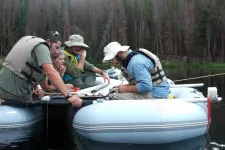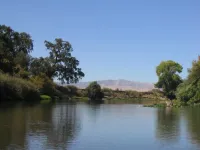More than a bumpy ride: turbulence offers boost to birds
2021-06-14
(Press-News.org) ITHACA, N.Y. - Most sensible air travelers dread turbulence. A little atmospheric hiccup can shake airplanes, rattle nerves and spill beverages. A Cornell University-led study found that birds don't mind at all.
By combining wind speed data with the measured accelerations of a golden eagle outfitted with GPS tracking instruments, the researchers suggest that, rather than hindering flight, turbulence is a source of energy that birds may use to their advantage.
This counterintuitive discovery could revise what we know about avian flight, and help the aerospace industry develop faster, more efficient ways to fly in turbulent environments.
The paper, "Turbulence Explains the Accelerations of an Eagle in Natural Flight," published in PNAS. The lead author was doctoral student Kasey Laurent.
While the flight of birds may appear easy and graceful to earthbound spectators, winged animals are actually navigating air flow that is structured, textured and constantly in flux, according to Gregory Bewley, assistant professor in the Sibley School of Mechanical and Aerospace Engineering, who led the team.
In order to take his experiments out of the lab and into the sky, Bewley's team partnered with two groups - Conservation Science Global and Cellular Tracking Technologies. Scientists from these companies captured a female golden eagle in Alabama, rigged it with a solar GPS telemetry unit with an accelerometer weighing less than 3 ounces, then released the bird.
Over the course of 17 days, as the eagle migrated north along the Appalachian Mountains toward Canada, the GPS "backpack" transmitted more than 200 hours of data - including location coordinates, altitude, ground speed and tri-axial acceleration - via cellular networks.
Bewley's lab then obtained wind speed data from the National Centers for Environmental Prediction's weather history databases and mapped it onto the eagle's flight measurements, identifying the bird's various flying and nonflying behaviors.
They found a "highly irregular, fluctuating pattern" in the eagle's accelerations, which resembles the typical trajectories of particles in turbulent airflows. At timescales ranging from 0.5 to 10 seconds - which translates to approximately 1 to 25 wingbeats - the eagle's accelerations and atmospheric turbulence were completely in synch.
And just how intense are these accelerations? As a point of comparison, people riding in a car or aboard a commercial flight experience less than 0.1 g, or one factor of earth's gravitational acceleration. Meanwhile, the accelerations of birds exceed 1 g - which would throw those human passengers out of their seats.
Of course, aeronautical engineers strive to reduce turbulence as much as possible, and no airline passenger or pilot wants a bumpy ride. But Bewley believes there are opportunities to harness the energy of turbulence, particularly for person-less transport and small reconnaissance aircraft.
"If you could find a path in which every vortex is pushing you the right way, then obviously you get there a little faster with a little less energy," Bewley said. "We're still working hard to understand turbulence by itself. I think it's fascinating that there might be some practical empirical knowledge embodied in wildlife that we don't appreciate yet."
INFORMATION:
The research was partially funded by the Friends of Talladega National Forest.
ELSE PRESS RELEASES FROM THIS DATE:
2021-06-14
Pancreatic cancer is an aggressive disease in which malignant cells form in the tissues of the pancreas, a long and flat gland located behind the stomach that helps with digestion and blood sugar regulation. Because pancreatic cancer is difficult to detect early, it is associated with a low survival rate, accounting for just over 3% of all new cancer cases in the U.S., but leading to nearly 8% of all cancer deaths, according to the National Cancer Institute.
Through a pre-clinical study conducted in his former role at Moffitt Cancer Center and published in Clinical Cancer Research, Said Sebti, Ph.D., associate director for basic research at VCU Massey Cancer Center, identified a novel drug that effectively thwarts pancreatic tumors that are addicted ...
2021-06-14
Analyzing how people move about in their daily lives has long been important to urban planners, traffic engineers, and others developing new infrastructure projects.
But amid the social restrictions and quarantine policies imposed during the global spread of COVID-19--which is directly linked to the movement of people--human mobility patterns changed dramatically.
To understand just how COVID-19 affected human movement on a global scale, Shouraseni Sen Roy, a professor in the College of Arts and Sciences Department of Geography and Sustainable Development, and graduate student Christopher Chapin developed COVID-19 vs. Human Mobility, an innovative and interactive web application that, shared in a new ...
2021-06-14
In polymicrogyria, the cortex of the brain has many irregular, small folds (gyria) and disorganization of its layers. Many affected children have severe developmental delay, intellectual disabilities, and epilepsy, and many need to use a wheelchair. Mutations in several different genes can cause this "overfolding of the brain" condition.
Studying four patients with polymicrogyria, Richard Smith, PhD, identified mutations in a gene that caused him to do a double-take. His curiosity drove him to investigate the role of this gene, called ATP1A3, in the developing brain.
"ATP1A3 is critical to many cell biological processes," says Smith, an investigator the Division of Genetics and Genomics at Boston Children's Hospital. ...
2021-06-14
Those who deactivated their Facebook profiles report a lower regard for other ethnic groups, and this effect was more prevalent among people living in more ethnically homogenous areas, shows a new study of users in Bosnia and Herzegovina (BiH). The findings run counter to a commonly held view that social media usage exacerbates societal polarization.
The work, conducted by researchers at New York University's Center for Social Media and Politics (CSMaP), appears in the Proceedings of the National Academy of Sciences (PNAS).
"For all our attention to the online drivers of polarization, we should not forget about the importance of offline factors as well," ...
2021-06-14
MISSOULA - Following 2020's extreme fire season, high-elevation forests in the central Rocky Mountains now are burning more than at any point in the past 2,000 years, according to a new University of Montana study set to publish in the Proceedings of the National Academy of Sciences.
Researchers from UM and the University of Wyoming analyzed a unique network of fire-history records to understand how 21st-century fire activity compares to wildfires in the past. The findings highlight that burning in recent decades in high-elevation forests of northern Colorado and southern Wyoming is unprecedented over the past several millennia.
As fire paleoecologists - scientists who study historical ecosystems - the team uses charcoal found in lake sediments to piece together the fire ...
2021-06-14
PULLMAN, Wash. - You can take a fish out of toxic water, but its epigenetic mutations will remain for at least two generations.
A research team led by Washington State University scientists analyzed the epigenetics--molecular factors and processes that determine whether genes are turned on or off--of a group of Poecilia mexicana fish, or Atlantic molly, that live in springs naturally high in hydrogen sulfide, which is normally toxic to most organisms.
The researchers removed a sample of fish from the toxic water and bred them in freshwater. They found that the grandchildren of the sulfidic-adapted fish had more epigenetic marks ...
2021-06-14
EVANSTON, Ill. --- The human gut is more than a source of instinct.
A new Northwestern University study is the first to explicitly address the gut microbiome as a pathway to understanding how environmental inequities could lead to health disparities.
Biological anthropologist Katherine Amato, assistant professor of anthropology at the Weinberg College of Arts and Sciences at Northwestern, is the study's lead author.
Amato says, despite a rich body of literature documenting environmental impacts on the microbiome, and the microbiome's impact on human health, ...
2021-06-14
International team used the stomach bacteria Helicobacter pylori as a biomarker for ancient human migrations
DNA sequences catalogued at University of Warwick in EnteroBase, a public genomes database, demonstrate that a migration of Siberians to the Americas occurred approximately 12,000 years ago
Project began in 2000s but new statistical techniques allowed researchers to reconstruct and date the migrations of Siberian Helicobacter pylori
Early migrations of humans to the Americas from Siberia around 12,000 years ago have been traced using the bacteria they carried by an international team including scientists at the University of ...
2021-06-14
Certain patients with an aggressive form of ovarian cancer have a better chance of a cure through surgical removal of their tumor before chemotherapy instead of the reverse, a new study shows.
Led by researchers at NYU Grossman School of Medicine, Perlmutter Cancer Center, and Dana-Farber Cancer Institute, the study used a mathematical tool to examine how doctors should coordinate available treatments for high-grade serous ovarian cancer (HGSC).
Ovarian cancer is the 8th most common cancer and cancer death in women worldwide, and HGSC constitutes roughly 70 percent of ovarian malignancies and has the worst prognosis. Patients with the condition typically undergo surgery and chemotherapy, but there has been long-standing controversy over the best order of treatment.
Published ...
2021-06-14
A study of woodland ecosystems that provide habitat for rare and endangered species along streams and rivers throughout California reveals that some of these ecologically important areas are inadvertently benefitting from water that humans are diverting for their own needs. Though it seems a short-term boon to these ecosystems, the artificial supply creates an unintended dependence on its bounty, threatens the long-term survival of natural communities and spotlights the need for changes in the way water is managed across the state.
"We need to be more intentional in incorporating ecosystem water needs when we manage water--both for aquatic organisms and species on land," said Melissa Rohde, the lead author of a study published June ...
LAST 30 PRESS RELEASES:
[Press-News.org] More than a bumpy ride: turbulence offers boost to birds



